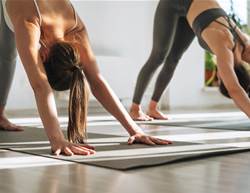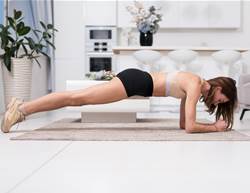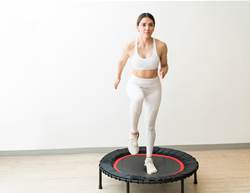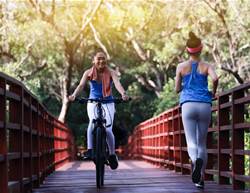Osteoarthritis is extremely common in physically active people and professional athletes. Around 2.1 million Australians have this condition and 7.3 million Australians live with a musculoskeletal condition in general. Since Tiff Hall was diagnosed with osteoarthritis a few years ago, it has had a huge impact on her life and approach to fitness. We ask her all about it.
Can you please tell us about your own experience with osteoarthritis?
Being diagnosed with osteoarthritis has really impacted me, especially as I am a professional trainer who enjoys moving my body and helping others to do the same. My knees have taken a lot of wear and tear over the years. From enjoying kicking and full contact sports such as Taekwondo for over 30 years to being a Gladiator, I’ve trained hard for a long time and even severed my ACL when I was 21 which lead to knee problems over many decades. I was then diagnosed with stage 4 chondromalacia of the patella, basically bone on bone osteoarthritis. Not fun. It took me a long time to accept I could no longer run 10km or do weighted squats.
While I can’t move my body in the same way I used to, learning new exercises with similar benefits has been a fun and educational task. I’ve had to find the sweet spot where I can remain active without overusing my muscles and joints and remember that being diagnosed with a musculoskeletal disease is not the end for movement—it’s something I grappled with in the beginning. However, staying active is one of the best things you can do.
It was a long journey to get to where I am today but after working to implement these new techniques and practices into my daily activities, I have a new sense of respect for my body and all it endures to maintain my lifestyle. The constant motivation to help others through my profession has been a fantastic reminder of why I do what I do and is ultimately how I keep doing it!
Were you surprised with your diagnosis?
I was surprised to learn that I had osteoarthritis especially as a few years ago, the word ‘arthritis’ was something I associated with getting old and is not something I ever thought would happen to me, not at this age at least. I think it’s something widely misinterpreted and unfortunately is far from an ‘old person’s disease’. It’s called a silent epidemic for a reason and the diagnosis was definitely something that took time to wrap my head around.
This is part of the reason why I have teamed up with Musculoskeletal Health Australia and Epijoint for the World’s Biggest Sit-In record breaking attempt on Thursday October 31, to not only raise awareness but help Australians learn how to keep active when faced with a similar condition.
What can people do to help prevent musculoskeletal disease like this generally?
There is no single magic answer here unfortunately! Some ways to help limit the likelihood of musculoskeletal conditions can be implementing proactive habits into your day to look after your joints.
Warming up and stretching before physical activity is a big one, it improves blood flow, range of motion and overall performance. For those who spend the bulk of their day at a desk, it’s important to get up every 30 minutes to stretch and adjust the prolonged posture our bodies take on when hunched over a computer. Lift with your legs! This is a common thing I work to adjust with others daily, it’s important not to overuse our back muscles as you can get injured or worse! If it’s something heavy, perhaps leave it for someone else to grab.
Overall, there’s not one fix! But, if you do have a musculoskeletal condition and are able to, keeping active in some form is an absolute must to managing symptoms or alleviating pain.
Back pain is one of the most common forms of MD – what can people do to prevent it?
Posture is definitely one of the biggest contributors to exacerbating back pain, reminding yourself to sit up, stand up or stretch is really important when going about your daily activities. Posture is also important when it comes to staying active or lifting something, if it looks too heavy, then it probably is!
Don't test boundaries. Support with supplements and icing/heating the area is a great step to add to your everyday routine and is something that can be done morning or night when you get ready for the day or are wanting to unwind. If you’re an active person, implementing yoga or Pilates to your workout regime can assist with posture and overall mobility as it helps to strengthen and stretch back muscles.
What has helped you on your health journey?
Staying consistent! Strength and stretching can go a long way in alleviating some of the symptoms I experience daily with a musculoskeletal condition like osteoarthritis. There’s no cure for this condition so working to control and manage my symptoms has been incomparable to my journey, as well as seeking out supplements to support my joint health. Managing the mental toll has also been tough but the support from my TXO community and continuing to persist and keep my body moving, helps me feel positive and ready to tackle any challenge.
Tiff Hall has teamed up with Musculoskeletal Health Australia and Epijoint for the World’s Biggest Sit-In record breaking attempt on Thursday October 31. Support the cause either virtually or at the Melbourne Event.









